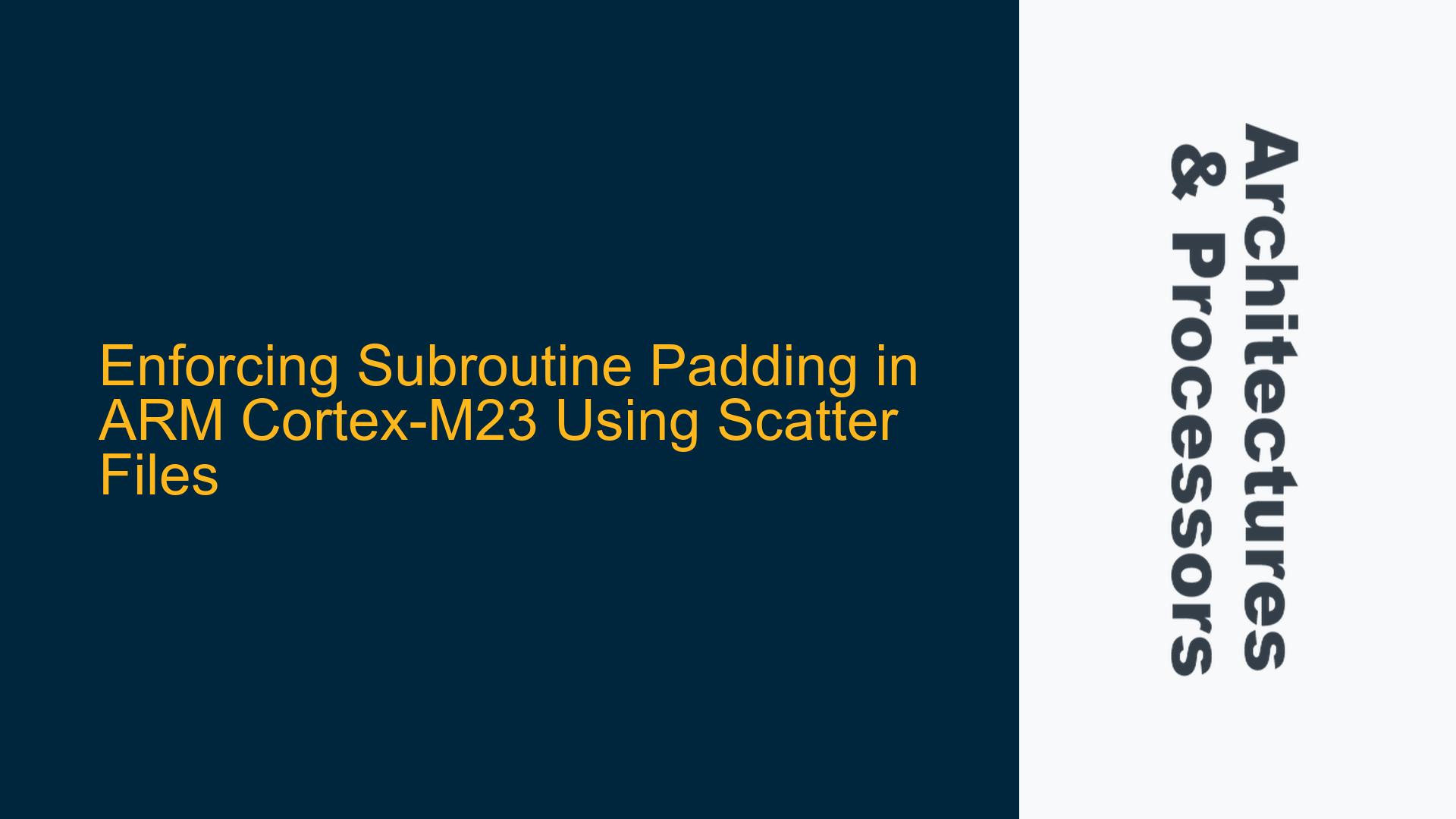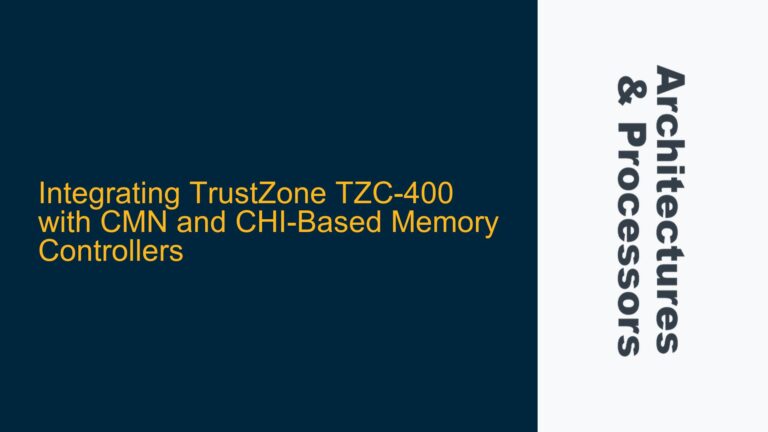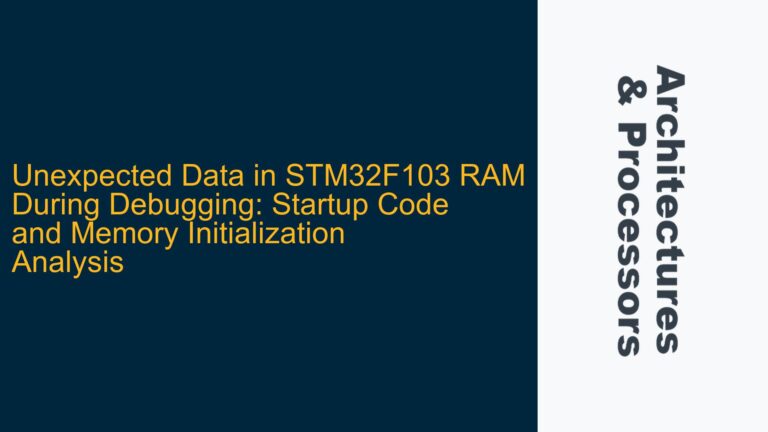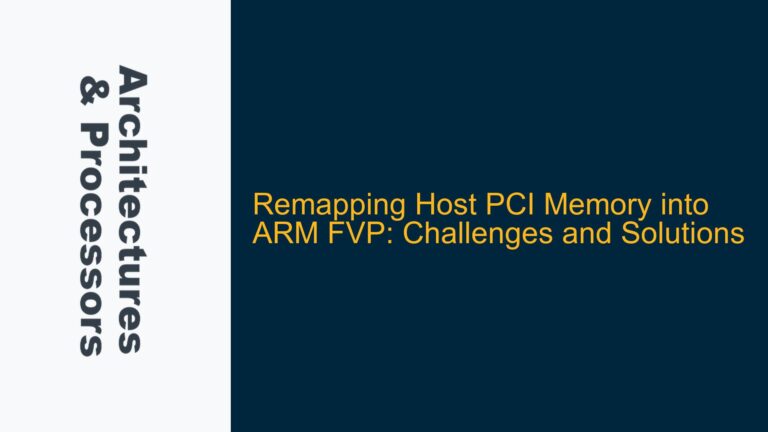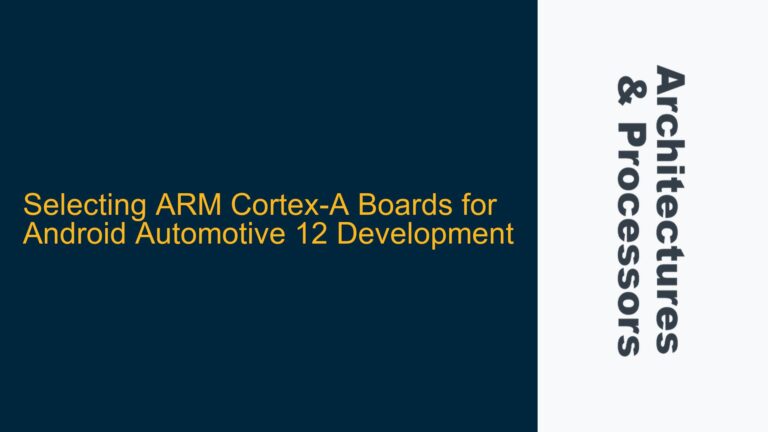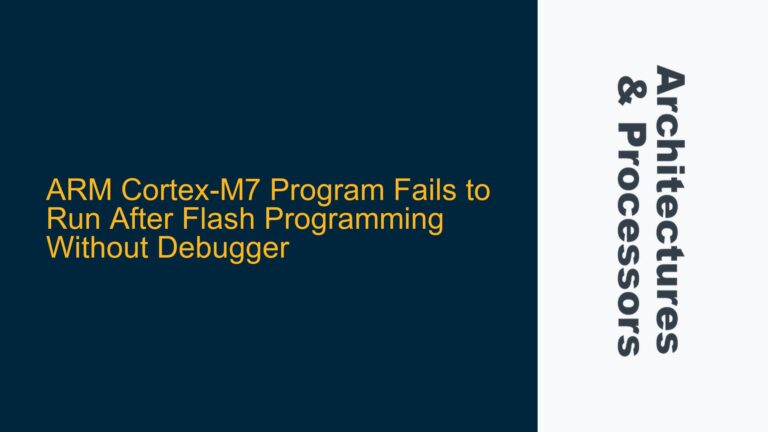ARM Cortex-M23 Subroutine Padding Challenges with Scatter Files
The ARM Cortex-M23 microcontroller, known for its efficiency in embedded systems, often requires precise memory management to meet specific application requirements. One such requirement is enforcing padding between subroutines in the memory layout. This is particularly important in scenarios where memory alignment, security, or debugging necessitates controlled spacing between functions. However, achieving this level of control using scatter files can be challenging, especially when dealing with veneer code and specific alignment attributes like ALIGNALL.
The scatter file is a powerful tool in the ARM toolchain for defining memory regions and their properties. It allows developers to specify how code and data are placed in memory, including alignment and padding requirements. However, the ALIGNALL attribute, which is commonly used to enforce alignment, does not always provide the granularity needed for subroutine padding. Additionally, veneer code, which is automatically generated by the linker for function calls between different memory regions, complicates the process further.
In this guide, we will explore the challenges of enforcing subroutine padding in ARM Cortex-M23 using scatter files, identify the root causes of these challenges, and provide detailed troubleshooting steps and solutions.
Veneer Code and ALIGNALL Attribute Limitations
The primary issue revolves around the inability to enforce precise padding between subroutines, particularly when veneer code is involved. Veneer code is generated by the linker to facilitate function calls between different memory regions, such as when transitioning between secure and non-secure states in ARMv8-M architectures. This code is essential for maintaining the integrity of function calls but introduces complications when trying to enforce specific padding requirements.
The ALIGNALL attribute in scatter files is designed to align the start of an execution region to a specified boundary. For example, ALIGNALL 32 ensures that the region starts at a 32-byte boundary. However, this attribute does not provide control over the padding between individual subroutines within the region. Furthermore, the ALIGNALL attribute does not consistently apply to veneer code, leading to misalignment issues.
In the provided scatter file example, the ER_ROM_CODE2 region is intended to store veneer code with a 32-byte alignment. However, the linker output reveals that the veneer code within this region does not adhere to the specified alignment. This misalignment can lead to inefficiencies in memory usage, potential security vulnerabilities, and difficulties in debugging.
Scatter File Configuration and Toolchain Behavior
The scatter file configuration plays a critical role in determining how code and data are placed in memory. In the example provided, the scatter file defines two load regions (LR_ROM and LR_ROM2) and corresponding execution regions (ER_ROM_CODE and ER_ROM_CODE2). The ER_ROM_CODE2 region is specifically designated for veneer code using the *(Veneer$$Code) selector.
The ALIGNALL 32 attribute is applied to both ER_ROM_CODE and ER_ROM_CODE2 regions, indicating that the start of each region should be aligned to a 32-byte boundary. However, the linker output shows that while the start of the ER_ROM_CODE2 region is aligned correctly, the individual veneer subroutines within the region are not padded as expected.
This behavior can be attributed to the way the ARM toolchain handles veneer code. Veneer code is generated dynamically by the linker, and its placement is influenced by various factors, including the memory layout and the specific requirements of the function calls it facilitates. As a result, the ALIGNALL attribute, which operates at the region level, does not extend to the individual subroutines within the region.
Additionally, the toolchain version (MDK-ARM 5.30.0.0) may have specific limitations or bugs related to the handling of veneer code and alignment attributes. It is essential to consider the toolchain’s behavior when diagnosing and resolving such issues.
Implementing Custom Padding and Alignment Solutions
To address the challenges of enforcing subroutine padding in ARM Cortex-M23, we need to explore alternative approaches that provide greater control over memory layout. These solutions involve a combination of scatter file modifications, linker script enhancements, and toolchain-specific configurations.
Custom Padding Using FILL Attribute
One approach to enforce padding between subroutines is to use the FILL attribute in the scatter file. The FILL attribute allows developers to specify a pattern that fills unused memory within a region. By strategically placing FILL directives between subroutines, we can achieve the desired padding.
For example, consider the following modified scatter file:
LR_ROM 0x10040000 0x10000 {
ER_ROM_CODE +0 ALIGNALL 32 {
*.o (+RO)
}
}
LR_ROM2 0x10050000 {
ER_ROM_CODE2 +0 ALIGNALL 32 {
*(Veneer$$Code)
FILL 0xFFFFFFFF ; Fill unused space with a specific pattern
}
RW_IRAM_THREAD_CODE 0x30008000 0xE800 {
*(+RW, +ZI)
}
}
In this example, the FILL 0xFFFFFFFF directive is used to fill unused space within the ER_ROM_CODE2 region. While this approach does not directly enforce padding between subroutines, it ensures that any unused space is filled with a specific pattern, which can be useful for debugging and memory analysis.
Manual Subroutine Placement
Another approach is to manually place subroutines in specific memory locations using the scatter file. This method provides precise control over the placement of each subroutine, allowing developers to enforce padding as needed.
For example, consider the following scatter file configuration:
LR_ROM 0x10040000 0x10000 {
ER_ROM_CODE +0 ALIGNALL 32 {
*.o (+RO)
}
}
LR_ROM2 0x10050000 {
ER_ROM_CODE2 +0 ALIGNALL 32 {
*(Veneer$$Code)
}
ER_ROM_CODE3 +0 ALIGNALL 32 {
*(.text.SecureContext_SaveContext)
FILL 0xFFFFFFFF ; Padding after SecureContext_SaveContext
*(.text.SecureContext_LoadContext)
FILL 0xFFFFFFFF ; Padding after SecureContext_LoadContext
*(.text.SecureContext_AllocateContext)
FILL 0xFFFFFFFF ; Padding after SecureContext_AllocateContext
*(.text.SecureContext_FreeContext)
}
RW_IRAM_THREAD_CODE 0x30008000 0xE800 {
*(+RW, +ZI)
}
}
In this example, each subroutine is explicitly placed in the ER_ROM_CODE3 region, with FILL directives used to enforce padding between them. This approach provides granular control over subroutine placement and padding but requires detailed knowledge of the code structure and may increase the complexity of the scatter file.
Toolchain-Specific Solutions
Given the limitations of the ALIGNALL attribute and the challenges associated with veneer code, it is essential to consult the toolchain documentation and support resources for specific solutions. For example, the MDK-ARM toolchain may provide additional attributes or linker options that can be used to enforce subroutine padding.
In some cases, upgrading to a newer version of the toolchain may resolve known issues related to alignment and veneer code. Additionally, reaching out to the toolchain vendor’s support team can provide valuable insights and potential workarounds for specific challenges.
Conclusion
Enforcing subroutine padding in ARM Cortex-M23 using scatter files is a complex task that requires a deep understanding of the toolchain, memory layout, and code structure. While the ALIGNALL attribute provides a starting point for alignment, it does not offer the granularity needed for precise padding between subroutines, especially when dealing with veneer code.
By exploring alternative approaches such as custom padding using the FILL attribute, manual subroutine placement, and toolchain-specific solutions, developers can achieve the desired memory layout and address the challenges associated with subroutine padding. It is essential to carefully analyze the linker output, consult the toolchain documentation, and leverage support resources to ensure a robust and efficient implementation.
In summary, the key to successfully enforcing subroutine padding lies in a combination of scatter file modifications, linker script enhancements, and a thorough understanding of the toolchain’s behavior. By following the detailed troubleshooting steps and solutions outlined in this guide, developers can overcome the challenges and achieve optimal memory management in their ARM Cortex-M23-based embedded systems.
